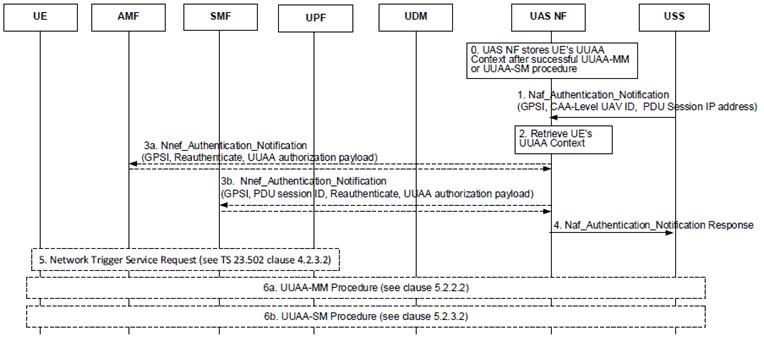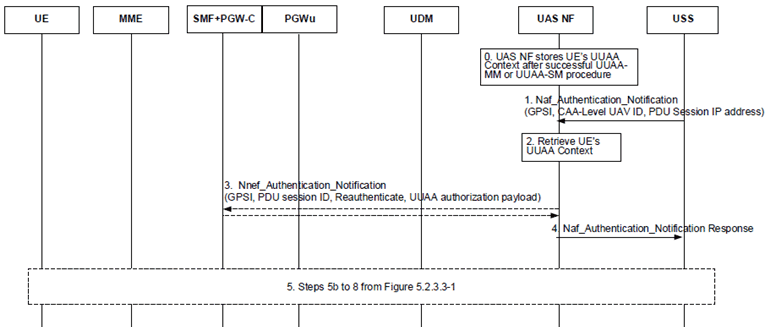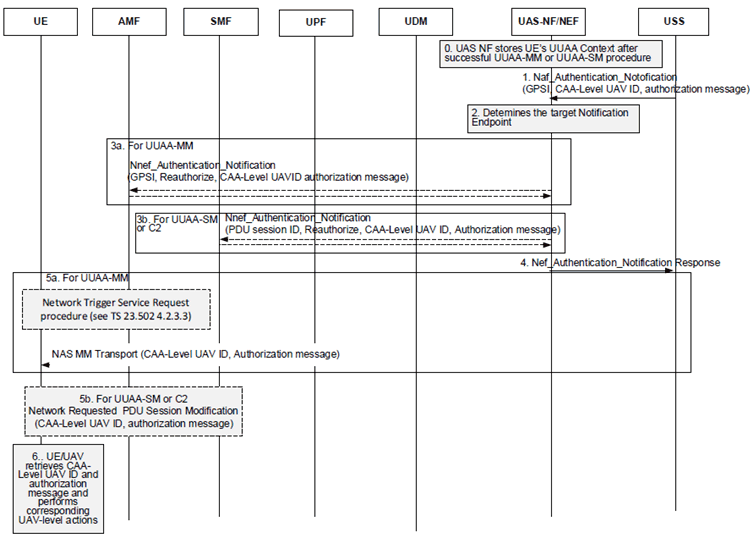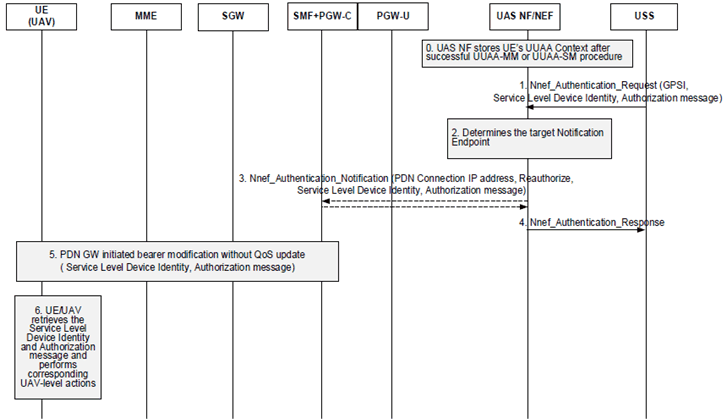Content for TS 23.256 Word version: 19.1.0
1…
4…
4.2…
4.2.3…
4.3…
4.4…
4.5…
5…
5.2.3…
5.2.4…
5.2.5…
5.2.5.3…
5.2.5.4…
5.2.7
5.2.8…
5.2.9…
5.3…
5.4…
5.5…
5.12…
5.13…
5.14…
6…
6.2…
6.3…
6.3.4…
A…
5.2.4 UUAA Re-authentication and Re-authorization by USS/UTM
5.2.4.1 UAV Re-authentication procedure in 5GS
5.2.4.2 UAV Re-authentication procedure in EPS
5.2.4.3 USS initiated UAV Re-authorization procedure in 5GS
5.2.4.4 USS initiated UAV Re-authorization procedure in EPS
...
...
5.2.4 UUAA Re-authentication and Re-authorization by USS/UTM p. 41
5.2.4.1 UAV Re-authentication procedure in 5GS p. 41

UAS NF stores the UE UUAA context after successful UUAA procedure as explained in clause 5.2.2.2 for UUAA-MM and in clause 5.2.3 for UUAA-SM procedure. The UUAA context may be stored in the UDSF or may be stored locally in the UAS NF depending on deployments.
Step 1.
The USS sends a Naf_Authentication_Notification request to UAS NF for re-authentication of the UAV. The USS includes GPSI, CAA-Level UAV ID, PDU Session IP address if available in the re-authentication request and an authentication message to be transparently delivered to the UAV.
Step 2.
UAS NF retrieves the stored UUAA context for the UE. From the stored UUAA context the UAS NF determines the target AMF or SMF for sending the notification.
Step 3a or 3b.
The UAS NF sends Nnef_Authentication_Notification request to notify the target NF, i.e. either the AMF or the SMF, to initiate re-authentication of the UAV.
Step 4.
The UAS NF responds back to the USS indicating that re-authentication request has been successfully initiated
Step 5.
If UE is in CM_Idle state, the target NF (i.e. either the AMF or the SMF) initiates the Network Triggered Service Request procedures as described in clause 4.2.3.3 of TS 23.502.
Step 6a.
If UUAA-MM was performed, the AMF initiates re-authentication of the UAV as described in steps 4c to 10 of UUAA-MM procedure, clause 5.2.2.2.
Step 6b.
If UUAA-SM was performed, the SMF then initiates re-authentication of the UAV as described in steps 3c to 7 of the UUAA-SM procedure, clause 5.2.3.2.
5.2.4.2 UAV Re-authentication procedure in EPS p. 42

UAS NF stores the UE UUAA context after successful UUAA-SM procedure as explained in clause 5.2.3. The UUAA context may be stored in the UDSF or may be stored locally in the UAS NF depending on deployments.
Step 1.
The USS sends a Naf_Authentication_Notification request to UAS NF for re-authentication of the UAV. The USS includes GPSI, CAA-Level UAV ID, UE IP address in the re-authentication request and an authentication message to be transparently delivered to the UAV.
Step 2.
UAS NF retrieves the UE stored UUAA context. From the stored UUAA context the UAS NF determines the target SMF+PGW-C for sending the notification.
Step 3.
The UAS NF sends Nnef_Authentication_Notification request to notify the SMF+PGW-C, to initiate re-authentication of the UAV.
Step 4.
The UAS NF responds back to the USS indicating that re-authentication request has been successfully initiated
Step 5.
The SMF+PGW-C then initiates re-authentication of the UAV as in steps 5b to 8 in Figure 5.2.3.3-1: UUAA during PDN connection establishment at Attach procedure in EPS.
5.2.4.3 USS initiated UAV Re-authorization procedure in 5GS p. 43

UAS NF stores the UE UUAA context after successful UUAA procedure as explained in clause 5.2.2.2 for UUAA-MM and in clause 5.2.3 for UUAA-SM procedure. The UUAA context may be stored in the UDSF or may be stored locally in the UAS NF depending on deployments.
Step 1.
The USS sends a Naf_Authentication_Notification request to UAS NF for re-authorization of the UAV. The USS includes GPSI, CAA-Level UAV ID, Notification Correlation Information, an authorization message to be transparently delivered to the UAV. The CAA-Level UAV ID may be a new CAA-Level UAV ID. The authorization message may e.g. include a UUAA Authorization Payload, a C2 Authorization Result and a C2 Authorization Payload (e.g. containing C2 pairing information and C2 security information).
Step 2.
Based on the received GPSI and Notification Correlation Information from the USS, the UAS NF/NEF determines the corresponding Notification Correlation Information for Nnef_Authentication_Notification request.
Step 3a.
For UUAA-MM re-authorization, the UAS-NF/NEF sends a Nnef_Authentication_Notification request including the CAA-Level UAV ID and the authorization message to the serving AMF.
Step 3b.
For UUAA-SM re-authorization or C2 re-authorization, the UAS-NF/NEF sends a Nnef_Authentication_Notification request to the SMF serving the UUAA or C2 for the UE which includes the corresponding PDU session identity, CAA-Level UAV ID and the authorization message.
Step 4.
The UAS NF responds back to the USS indicating that re-authorization request has been successfully initiated.
Step 5a.
In the case of UUAA-MM:
If the UE is in CM_Idle state, the AMF initiates the Network Triggered Service Request procedures as described in clause 4.2.3.3 of TS 23.502.
The AMF delivers the CAA-Level UAV ID and the authorization message to the UE using NAS MM Transport.
Step 5b.
In the case of UUAA-SM or C2 re-authorization:
The SMF identifies, based on the received information, the PDU Session that is serving the UUAA-SM or C2 re-authorization and invokes the Network Requested PDU Session Modification procedure (Figure 4.3.3.2-1 of TS 23.502 triggering event SMF Requested modification) by sending Namf_Communication_N1N2MessageTransfer , including the CAA-Level UAV ID and the authorization message in the N1_SM_Container (step 3b in Figure 4.3.3.2-1 of TS 23.502) .
The Network Triggered service request procedure is invoked by AMF to forward the CAA-Level UAV ID and the authorization message included in the N1_SM_container to the UE (from step 3a in Figure 4.2.3.3-1 of TS 23.502).
Step 6.
The UE receives the CAA-Level UAV ID and the authorization message, which may e.g. include a UUAA Authorization Payload, a C2 Authorization Result and a C2 Authorization Payload (e.g. containing C2 pairing information and C2 security information). The UE acts on it accordingly (outside the scope of 3GPP).
5.2.4.4 USS initiated UAV Re-authorization procedure in EPS p. 44

UAS NF/NEF stores the UE UUAA context after successful UUAA procedure as in clause 5.2.3 for UUAA-SM procedure. The UUAA context may be stored in the UDSF or may be stored locally in the UAS NF/NEF depending on deployments.
Step 1.
The USS sends a request to UAS NF/NEF for re-authorization of the UAV. The USS includes GPSI, Service Level Device Identity (e.g. CAA-Level UAV ID), Notification Correlation Information and authorization message to be transparently delivered to the UAV. The Service Level Device Identity (e.g. CAA-Level UAV ID) may be a new Service Level Device Identity (e.g. CAA-Level UAV ID). The authorization message may e.g. include a UUAA Authorization Payload, a C2 authorization result and a C2 Authorization Payload (e.g. containing, C2 pairing information and C2 security information).
Step 2.
Based on the received GPSI and Notification Correlation Information from the USS, the UAS NF/NEF determines the corresponding Notification Correlation Information for Nnef_Authentication_Notification request.
Step 3.
The UAS NF/NEF sends a Nnef_Authentication_Notification request to the SMF+PGW-C serving the UUAA or C2 which includes the corresponding PDN Connection identity, Service Level Device Identity (e.g. CAA-Level UAV ID) and the authorization message.
Step 4.
The UAS NF/NEF responds back to the USS indicating that re-authorization request has been successfully initiated.
Step 5.
The SMF+PGW-C identifies, based on the received information, the PDN Connection that is serving the UUAA-SM and invokes the PDN GW initiated bearer modification without QoS update procedure (Figure 5.4.3-1 of TS 23.401) by sending Update Bearer Request message, including the Service Level Device Identity (e.g. CAA-Level UAV ID) and the authorization message in the PCO.
The Update Bearer Request message including the Service Level Device Identity (e.g. CAA-Level UAV ID) and the authorization message is forwarded by MME as Downlink NAS Transport to the UE (steps 4 and 5 in Figure 5.4.3-1 of TS 23.401).
Step 6.
The UE receives the Service Level Device Identity (e.g. CAA-Level UAV ID) and the authorization message (which may e.g. include a UUAA Authorization Payload, a C2 authorization result and a C2 Authorization Payload (e.g. containing C2 pairing information and C2 security information). The UE acts on it accordingly (outside scope of 3GPP).